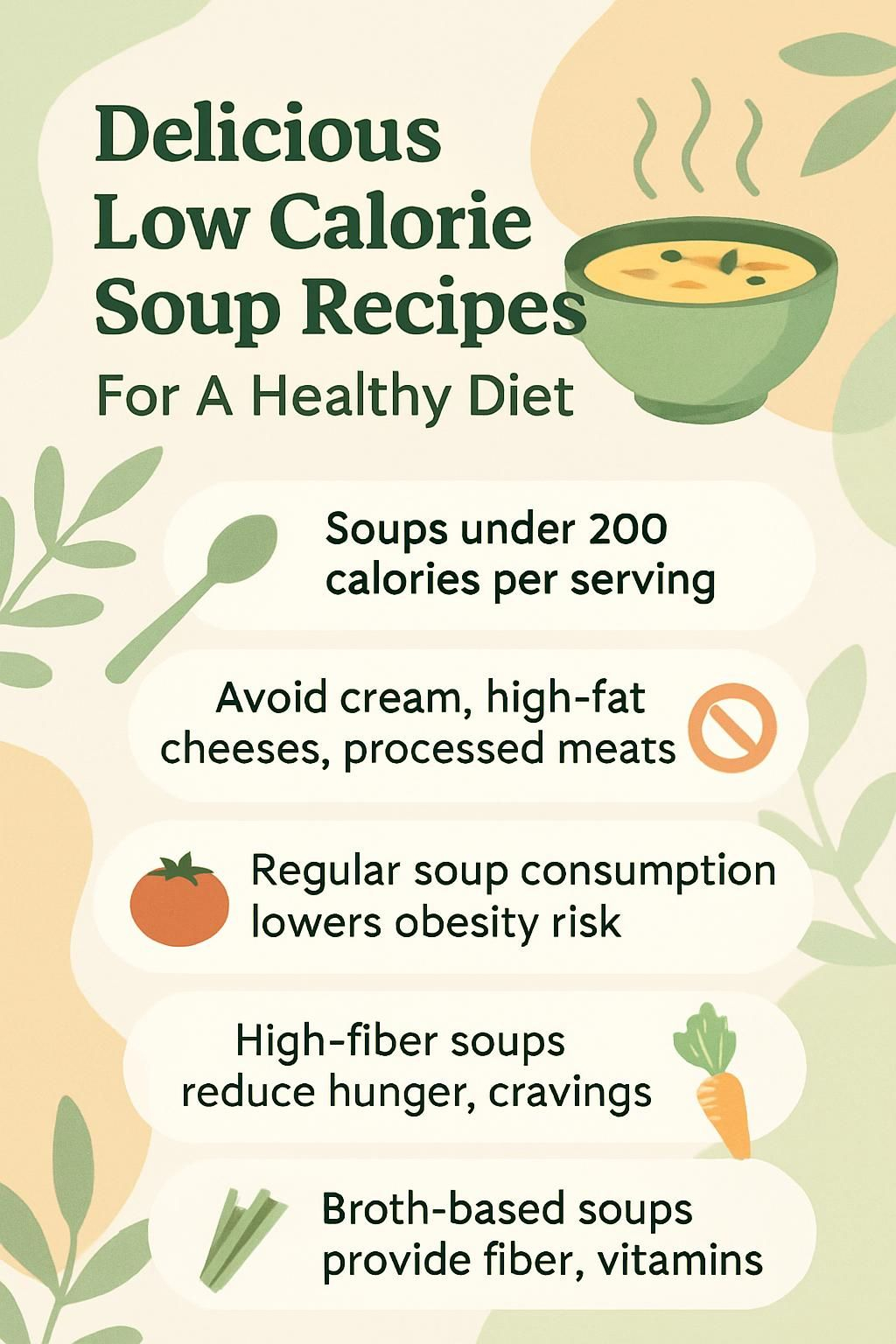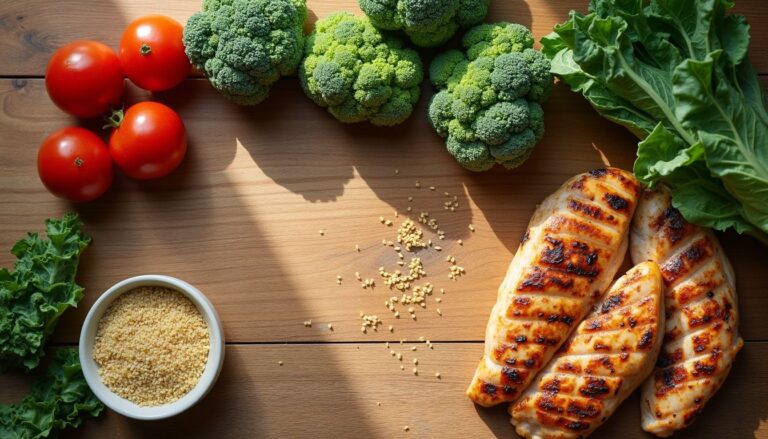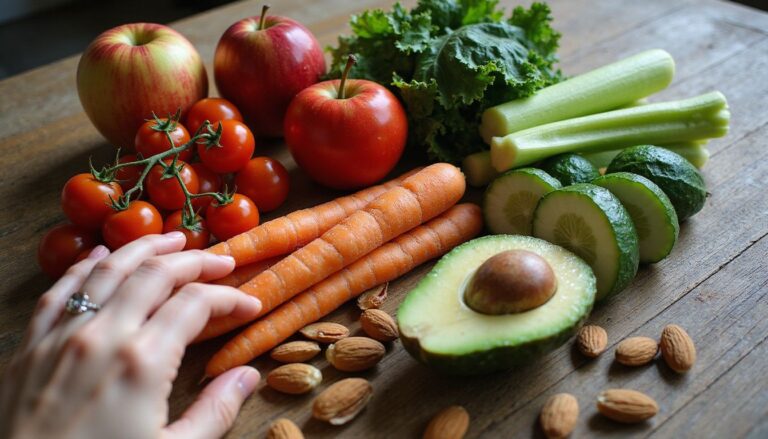Delicious Low Calorie Soup Recipes For A Healthy Diet
Our Nutrition Assistant AI Suite will transform your body. You will lose fat, get toned, and build muscle. Gain confidence and optimal health.
If healthy eating feels dull, a warm bowl of low-calorie soup can change that. Research suggests that vegetable-rich soups with lean protein or legumes help lower calorie intake and may support weight management. These low-calorie soup recipes are simple, affordable, and great for busy weeks.
In this guide, you will find easy vegetable soup ideas under 200 calories per serving plus smart flavor tips. You will also learn how to use broth, cabbage, lentils, cauliflower, and chicken to build satisfying meals without extra fat or sugar.
Start with one bowl today. Small steps make a healthy diet easier to enjoy.
Key Takeaways
- Low-calorie soups that feature vegetables, lean proteins, or legumes help you feel full, manage weight, and reduce calories per meal.
- People who eat soup regularly tend to have a lower risk of obesity, according to a 2020 analysis by Kuroda and colleagues.
- Broth-based soups using non-starchy vegetables like cabbage, carrots, and spinach deliver fiber and vitamins while staying under 200 calories per serving.
- Skipping heavy cream, high-fat cheese, flour-based thickeners, and processed meats keeps soups lower in fat and better for heart health, as public health guidance recommends.
- High-fiber soups such as lentil or black bean can curb hunger and snack cravings while helping steady blood sugar for long-term success.

Why Are Low-Calorie Soups Good for a Healthy Diet?

Low-calorie soups make healthy eating practical. They taste great, fill you up, and come together fast on the stovetop, in a pressure cooker, or in a slow cooker.
How Do Low-Calorie Soups Help With Weight Management?
Fiber-rich, broth-based soups help control calories while keeping portions generous. Vegetable soup, cabbage soup, and lentil soup feel hearty but are lighter than cream-based options.
A large serving of cabbage soup often has fewer than 200 calories per bowl due to its high water content and bulky vegetables. Regular soup eaters show lower odds of obesity in population studies, including a 2020 report by Kuroda et al.
High-fiber meals increase fullness, which helps you eat less later in the day. In short, soup makes healthy meals satisfying without piling on fat or sugar.
What Nutrients Do Low-Calorie Soups Provide?
Even with fewer calories, these soups deliver key nutrients. Lentil soup supplies B vitamins, folate, iron, potassium, and plenty of fiber with little fat. That makes it a heart-smart choice.
Bone broth offers minerals like calcium, magnesium, and phosphorus that support muscles and bones. Tomato soup brings antioxidants such as lycopene and vitamin C, which may help tame inflammation.
Butternut squash soup provides vitamin A, potassium, and fiber for vision and digestion. Miso soup with tofu and seaweed includes probiotics, which are helpful bacteria for gut health, along with plant protein.
Beans, leafy greens, carrots, and celery add more vitamins and minerals to every pot. Last winter, I blended a creamy cauliflower soup with garlic and pepper. It tasted rich, yet stayed light in calories and full of vitamin C and fiber.
Next, see how soup keeps you full much longer than you might expect.
How Do Low-Calorie Soups Promote Fullness and Reduce Hunger?
Soups do more than supply nutrients. They manage hunger. Fiber from lentils and beans slows digestion and increases satiety, so you feel satisfied for hours.
A 2023 study linked higher fiber intake with lower daily calories, which supports weight goals. Cabbage soup is a good example, since its fiber and water content deliver volume without many calories.
Adding lean protein, such as chicken or turkey, helps preserve muscle while you eat fewer calories. Protein also improves fullness signals to your brain.
When I packed split pea or black bean soup for lunch, my afternoon snack cravings dropped and my energy stayed steadier. As legumes and grains thicken broth, each bowl provides hydration and staying power.
A bowl of lentil or black bean soup can keep you full for hours because of the ideal mix of protein and fiber.
Tips for Making Delicious Low-Calorie Soups
You can build big flavor without big calories. Choose smart bases, add the right vegetables, and season boldly.
How Can I Use Broth as a Base for Low-Calorie Soups?
Start with chicken, vegetable, or bone broth for a light, flavorful base. Homemade or low-sodium options help you manage both salt and calories.
Chicken broth suits favorites like chicken noodle soup or chicken tortilla soup, since it is protein-rich but lower in fat. Clear broths also shine in plant-based soups and pho, usually under 70 calories per cup.
Load the pot with non-starchy vegetables such as zucchini, spinach, onions, and mushrooms to add dietary fiber without many calories. Shredded chicken or turkey boosts satiety in soups like turkey tortilla soup or simple chicken soup.
Flavor your broth with thyme, parsley, coriander, and pepper instead of cream or heavy sauces. For a bright, sweet-tart finish, use a splash of citrus or a little vinegar. These choices keep soups satisfying and weight-friendly.
What Are the Best Non-Starchy Vegetables to Add to Soups?
After picking your broth, build a filling soup with vegetables that add bulk, color, and nutrients. Non-starchy vegetables raise volume and keep calories low.
- Cabbage is rich in vitamin C, fiber, and vitamin K. It adds hearty texture to vegetable soup without many calories.
- Carrots bring color and sweetness. A medium carrot has roughly 25 calories, ideal for light recipes.
- Bell peppers deliver vitamin C and antioxidants. Any color works well in pepper soup or mixed vegetable soup.
- Green beans add fiber and crunch with minimal calories. They are great in Instant Pot soup or chicken soups.
- Zucchini adds volume and cooks fast. It blends smoothly if you want a green soup.
- Mushrooms add savory depth. Brown or button mushrooms also freeze well for meal prep.
- Broccoli supplies vitamin C, folate, and fiber. It thickens soups like light broccoli chowder and is perfect for plant-based meals.
- Cauliflower is low in calories and high in vitamin C. Blend it to mimic creamy potato soup without milk or flour.
- Spinach and Swiss chard wilt quickly and add iron plus vitamins A and C. Both are great in vegetarian soup.
- Asparagus offers spring flavor and few carbs. Trim woody ends before chopping.
- Tomatoes boost umami and color. Fresh or canned tomatoes add taste without fat.
I use these vegetables weekly because they help me stick to calorie goals without feeling hungry. Mix and match based on your taste and what is in season.
How Do I Incorporate Lean Proteins and Legumes into Soups?
Once you have a base of non-starchy vegetables, add lean proteins and legumes for staying power. Protein and fiber together help control appetite.
- Add shredded chicken or turkey breast to slow cooker chicken and vegetable soup. About 170 g of cooked chicken boosts protein in a 500-calorie pot.
- Use red lentils or split peas for fiber and protein. Two cups of dry red lentils usually yield about 250 calories per serving once cooked into a large batch.
- Toss in cannellini or black beans to add fiber and body. Beans also freeze well in soups.
- Include tofu cubes for a plant-based option. Miso soup with tofu and seaweed adds protein with very little fat.
- Stir in chickpeas for Mediterranean or Moroccan-inspired soups, such as a spiced chickpea stew.
- Combine legumes like white beans with gluten-free grains such as orzo or rice to create comfort food that stays light.
- Season meats, eggs, legumes, or tofu with cumin, clove, chili, nutritional yeast, or fresh herbs for bold flavor without butter or cheese.
- Skip fatty sausage and keep ham light. If using ham for flavor, choose lean cuts and small amounts.
- Sauté proteins briefly before adding broth to deepen flavor while using minimal oil.
- Refrigerate leftovers for quick meals. These protein- and fiber-packed soups are a lifesaver on busy nights.
With the right proteins and legumes, you can turn classic dishes into healthy comfort food without extra calories.
Which Herbs and Spices Enhance Soup Flavor Without Extra Calories?
Fresh herbs and spices transform light soups into crave-worthy meals. They add aroma, color, and depth while keeping calories near zero.
- Ginger, garlic, and turmeric bring warm, bold flavors to pumpkin soup or curry-style broths.
- Fresh cilantro brightens Mexican-style chicken tortilla soup and offers fresh color.
- Chili flakes add gentle heat that boosts tomato-based soups and stews.
- Italian seasoning with bay leaves and black pepper suits classic vegetable soups and weight-focused vegetable mixes.
- Lemon juice or vinegar adds brightness to gluten-free recipes, replacing heavy fats with acidity.
- Miso paste supplies savory umami in plant-based soups. Tamarind adds tangy balance in pumpkin or Thai-inspired soups with very few calories.
- Finish with basil or parsley. These herbs keep flavor even after freezing.
I often swap extra cheese for dill or thyme. One cold week, I used fresh ginger instead of bouillon in a zucchini cream soup and the flavor popped without any added fat.
What Ingredients Should I Avoid to Keep Soups Low in Fat and Calories?
Some add-ins can spike calories faster than you think. Keep your soup light by choosing ingredients with care.
- Avoid heavy cream, high-fat cheese, and butter. They raise calories quickly.
- Skip flour, sugar, or cornstarch thickeners. These add carbs and extra calories per bowl.
- Limit processed meats like sausage or fatty bacon. They add saturated fat and a lot of sodium.
- Pass on fried toppings such as croutons or crispy tortilla strips. A small handful can add over 100 calories.
- Use avocado or extra oil sparingly. Both are healthy fats, but they are calorie dense.
- Choose low-sodium broth to keep salt in check and reduce water retention.
- Omit dumplings if you want fewer calories. Dough adds starch and often fat.
- Pick lean proteins, such as white-meat chicken or beans, instead of fattier beef cuts.
- Go easy on high-fat cheeses as garnish. Small portions still add up across servings.
- Favor non-starchy vegetables over potatoes to keep soups filling but light.
I switched heavy cream for blended butternut squash using a standard blender. The soup tasted rich, the texture stayed silky, and the calories stayed low.
Classic Low-Calorie Soup Recipes
These classic recipes rely on fresh ingredients and simple techniques. Every bowl tastes comforting yet stays light.
What Are Easy Vegetable Soup Recipes?
Vegetable soup fits almost any healthy diet and comes together fast. Use this simple framework to build a tasty pot under 200 calories per serving.
- Start with a low-sodium vegetable broth for a clean, classic base.
- Chop carrots, celery, green beans, zucchini, bell peppers, broccoli, mushrooms, and add green cabbage for crunch.
- Add garlic and a sweet onion for aroma without extra fat.
- Stir in diced tomatoes for richness and vitamins A and C.
- Season with Italian herbs, a bay leaf, black pepper, and finish with lemon or lime for brightness.
- Simmer 25 to 30 minutes until vegetables are tender but not mushy.
- Expect about 126 calories per serving and roughly 5 g of protein if beans are included.
- Refrigerate for up to 7 days or freeze for up to 4 months.
- Use a teaspoon of olive oil to sauté onion and garlic, then cook the rest in broth.
- Skip heavy cream, cheese, and sausage. Finish with parsley or basil instead.
I cook a big batch on Sundays. It keeps weekday lunches simple and healthy.
How Do I Make Cabbage Soup for Weight Loss?
Cabbage soup is a satisfying, low-calorie staple. It is famous for quick-loss plans, though long-term diets should stay balanced.
- Use green cabbage for vitamin C, fiber, and vitamin K with very few calories.
- Add chopped carrots, celery, onion, and tomatoes for nutrients and flavor.
- Choose low-sodium broth or water to keep it hydrating and heart-friendly.
- Season with black pepper, garlic powder, and parsley instead of heavy fats.
- Simmer at least 30 minutes until the vegetables soften and flavors blend.
- Serve hot. One cup often contains fewer than 80 calories.
- Store-bought low-calorie vegetable soups can work in a pinch, but check labels for sodium.
- Avoid starchy vegetables like potatoes or corn if you want to keep carbs lower.
- Make enough for several meals. Cabbage soup reheats well during the week.
- Fresh ingredients usually mean more flavor and less sodium.
This approach supports weight management while keeping taste front and center. For medical conditions, ask your clinician about nutrition goals.
What Is a Healthy Lentil Soup Recipe?
Lentil soup is hearty, affordable, and high in protein and fiber. It is also easy to batch-cook for busy schedules.
- Gather 2 cups dry red lentils, 2 carrots, 1 large tomato, 1 large onion, 2 to 3 bouillon cubes, and 8 to 10 cups water.
- Rinse lentils under cold water to remove dust.
- Add lentils, bouillon, and water to a stockpot. Bring to a gentle boil and stir to dissolve bouillon.
- Blend the onion and tomato until smooth for a silky base.
- Slice the carrots into thin rounds for even cooking, then add to the pot with the blended mix.
- Reduce heat and simmer at least 20 minutes until lentils are soft.
- Season with salt and pepper. A large batch yields about eight servings near 250 calories each.
- Freeze leftovers in airtight containers. This soup holds texture after thawing.
- Swap red lentils for brown lentils if you prefer a heartier bite.
- Fiber-rich lentils support steady blood sugar and deliver B vitamins, folate, iron, and potassium.
Next, try a simple chicken and vegetable soup for extra protein.
How Can I Prepare Chicken and Vegetable Soup?
Chicken and vegetable soup brings lean protein to a light, comforting bowl. It is quick to make and easy to portion.
- Use 2.5 cups chicken stock as the base.
- Add 170 g of cooked shredded chicken breast for lean protein, about 24 g per serving.
- Stir in 300 g of frozen broccoli or cauliflower for vitamin C and fiber.
- Bring the stock to a boil. Add vegetables and chicken, then simmer until tender.
- Stir in 55 g of Greek yogurt at the end for creaminess without heavy cream or butter. The entire pot is near 500 calories.
- Blend for a smooth texture or leave chunky for a rustic finish.
- Season with parsley, thyme, black pepper, or paprika.
- Avoid starchy add-ins like potatoes or noodles to keep calories low.
- This recipe yields two hearty servings, about 250 calories each; perfect for portion control.
Lean chicken and a clear broth make a strong base for a satisfying soup that fits most healthy eating plans.
What Are Tips for Making Low-Calorie Tomato Soup?
Tomato soup is bright, rich, and naturally light. It delivers antioxidants and pairs well with lean sides.
- Use ripe tomatoes for peak flavor and more vitamin C and lycopene.
- Pick a low-sodium vegetable or chicken broth to keep it heart-friendly.
- Skip heavy cream. Blend tomatoes with steamed cauliflower or use unsweetened almond milk for creaminess.
- Season with basil, oregano, and thyme for depth without extra calories.
- Roast tomatoes at 400°F for 25 minutes to intensify sweetness before simmering.
- Serve with lean protein like grilled chicken or tofu for longer fullness.
- Avoid butter and cheese toppings. Fresh parsley or chives add flavor without fat.
- Stir in carrots or bell peppers to increase vitamin A and fiber.
- Round out the meal with whole grain toast or a side salad.
- Lycopene, found in tomatoes, may help reduce inflammation in the body.
I often make roasted tomato soup for lunch. It fills me up and never weighs me down.
Creamy Low-Calorie Soup Recipes
You can enjoy creamy textures without heavy cream. These recipes use vegetables and smart techniques to stay light.
How Do I Make Creamy Cauliflower Soup Without Cream?
Cauliflower makes a silky soup with very few calories. A blender creates a creamy finish without dairy.
- Sauté half an onion and two garlic cloves in a nonstick pot with a splash of broth.
- Add one head of chopped cauliflower for bulk and thickness.
- Pour in low-sodium chicken stock to cover the vegetables.
- Optional, add a small potato for added body without fat.
- Simmer 12 to 15 minutes until the cauliflower is very soft.
- Puree with an immersion or standard blender until smooth.
- Season with salt, pepper, and herbs like thyme or parsley.
- Serve warm. Calories often land between 40 and 70 per serving.
- This dairy-free method tastes rich while staying light.
Try the next recipe if you prefer a slightly sweet, cozy bowl.
What Is a Low-Calorie Butternut Squash Soup Recipe?
Butternut squash brings natural sweetness, color, and fiber. This version stays light and satisfying.
- Gather half a butternut squash, one carrot, one to two small potatoes, onion, garlic, turmeric, two stock cubes, and one can of brown lentils.
- Chop squash, potato, and carrot into even pieces.
- Sauté onion and garlic until soft for a flavorful base.
- Add turmeric for color and potential anti-inflammatory benefits.
- Pour in 1.5 liters of water and add stock cubes to form the broth.
- Simmer 20 minutes until vegetables are tender.
- Stir in the lentils for extra fiber and protein.
- Add half to one can of lite coconut milk for mild creaminess.
- Blend until smooth for a velvety texture.
- Expect about 250 to 300 calories per serving, depending on portions.
Up next, a light zucchini cream soup without dairy.
How Can I Prepare Zucchini Cream Soup Healthily?
Zucchini has high water content, which helps with hydration, and it blends into a silky soup. No cream needed.
- Gather two to three zucchinis, one medium onion, two tomatoes, and two garlic cloves.
- Heat one tablespoon olive oil to sauté onion and garlic. Use oil sparingly.
- Add sliced zucchini and chopped tomatoes. Cook until soft and fragrant.
- Pour in four cups of low-sodium bone broth or vegetable stock. Simmer 15 to 20 minutes.
- Blend carefully until smooth and creamy.
- Season with basil or thyme and black pepper. Skip cream and cheese.
- Serve hot or chilled as part of lunch or dinner, including plant-based plans.
I made this during summer with garden zucchinis. Everyone enjoyed the creamy texture without dairy.
What Are Ingredients for Creamy Carrot and Ginger Soup?
Carrot and ginger soup is bright, smooth, and warming. It is easy to make and easy to freeze.
- Use 4 to 5 cups of sliced carrots for natural sweetness and vitamin A.
- Add about one tablespoon peeled, grated fresh ginger for gentle heat.
- Chop one medium yellow onion to deepen flavor.
- Pour in four cups of vegetable or chicken broth.
- Stir in half a cup of Greek yogurt or lite coconut milk after blending.
- Sauté aromatics with one tablespoon olive oil, then build the soup in broth.
- Season with salt and pepper. Use low-sodium broth to limit salt.
This base works with other spices too, such as curry powder or turmeric.
Unique Low-Calorie Soup Ideas
Fresh flavor keeps healthy eating exciting. Try these global-inspired bowls for variety.
How Do I Make Cannellini Bean and Kale Soup?
This bean and greens soup is simple, protein-rich, and satisfying. It is perfect for meal prep.
- Rinse one cup dried cannellini beans or use a 15-ounce can of no-salt-added beans.
- Heat one tablespoon olive oil and sauté chopped onion, celery, and carrot for five minutes.
- Add four cups of low-sodium vegetable broth.
- Stir in the beans with two cups of finely chopped kale.
- Bring to a boil, then simmer about 15 minutes until tender.
- Season with garlic powder, black pepper, thyme, or Italian herbs.
- Finish with parsley or lemon juice for a fresh lift.
What Is a Spicy Moroccan Chickpea Soup Recipe?
Spiced chickpea soup offers warmth, color, and fiber. The spices deliver flavor while staying light.
- Use a low-sodium vegetable or chicken broth to keep calories low.
- Sauté chopped onions, minced garlic, carrots, and celery in one tablespoon olive oil until softened.
- Stir in canned diced tomatoes and cooked chickpeas, about one cup per four servings.
- Season with cumin, coriander, turmeric, smoked paprika, black pepper, and a pinch of cayenne.
- Simmer 20 to 25 minutes so flavors blend well.
- Fold in spinach or kale near the end for more nutrients.
- Adjust spices to taste and garnish with cilantro or parsley.
- Each serving supplies protein from legumes, vitamins from vegetables, and antioxidants from spices.
Layering spices with vegetables and chickpeas creates a filling, low-calorie soup packed with nutrient density.
How Can I Prepare Miso Soup With Tofu and Vegetables?
Miso soup is light, savory, and fast. It typically starts very low in calories and scales well for a meal.
- Use low-sodium vegetable broth or water as the base.
- Dissolve one tablespoon miso paste per two cups of liquid. White or yellow miso tastes mild.
- Cube firm tofu into bite-size pieces and add about half a cup per serving.
- Slice mushrooms, spinach, napa cabbage, carrots, or green onions. Add up to one cup per serving.
- Stir in dried seaweed like wakame for minerals and classic flavor.
- Simmer vegetables until just tender. Avoid boiling after adding miso to protect beneficial bacteria.
- Add tofu in the last few minutes so it warms without breaking.
- Top with chopped scallions or a pinch of sesame seeds.
- Serve right away for the best flavor and texture.
Next up, a bright Thai-style soup that is big on herbs and light on calories.
What Are Tips for Making Thai-Inspired Lemongrass Soup?
Thai-style lemongrass soup, like a light Tom Yum, packs citrusy aroma and gentle heat. It is refreshing and tidy on calories.
- Use fresh lemongrass stalks and slice them thin to infuse the broth.
- Add ginger, garlic, and chili flakes for depth without fat.
- Choose a clear chicken or vegetable broth to keep it light.
- Fill the pot with mushrooms, tomatoes, carrots, and bell peppers.
- Pick lean proteins such as shrimp, tofu, or poached chicken breast.
- Skip coconut cream. Use lite coconut milk only if you want subtle richness.
- Finish with fresh lime juice to brighten the soup.
- Garnish with cilantro and green onions rather than fried toppings.
- Serve hot to enjoy the delicate aromas at their peak.
- Use fish sauce sparingly, since it is salty.
I made this with tofu and leftover vegetables from my fridge. My family loved how light it felt after a heavy lunch; no one missed cream or oil.
Slow Cooker Low-Calorie Soups
A slow cooker lets you set it and get on with your day. Dinner is hot, balanced, and ready when you are.
How Do I Make Turkey Noodle Soup in a Slow Cooker?
Turkey noodle soup is simple, comforting, and lean. Whole grain noodles bring extra fiber for fullness.
- Use shredded turkey breast for lean protein.
- Add carrots, celery, and onions for vitamins and flavor.
- Pour in 6 to 8 cups of low-sodium chicken or turkey broth.
- Choose whole wheat or quinoa pasta for fiber and steady energy.
- Season with thyme, parsley, and black pepper.
- Cook on low for 6 to 8 hours so flavors meld and the meat stays tender.
- Skim any fat from the surface to keep it light.
- Serve with extra fresh herbs for brightness.
This bowl checks all the boxes, lean protein, vegetables, and whole grains.
What Is a Hearty Vegetable Stew Recipe for Slow Cooking?
A vegetable stew can taste rich while staying light on calories. The slow cooker does the work while you handle your day.
- Use a mix of carrots, green beans, celery, tomatoes, and squash, at least three cups chopped.
- Add one cup of beans or lentils for protein and fiber.
- Pour in four cups of low-sodium vegetable broth.
- Season with thyme, rosemary, bay leaves, salt, and pepper.
- Cook on low for 7 to 8 hours until thick and tender.
- Stir a few times if you can to blend flavors.
- Skip cream and fatty meats to keep calories in check.
- Top with fresh herbs before serving.
How Can I Prepare Chicken Tortilla Soup in a Slow Cooker?
Chicken tortilla soup offers bold flavor with simple prep. Baking the tortilla strips keeps calories lower.
- Add boneless, skinless chicken breast cut into bite-size pieces.
- Pour in 4 cups low-sodium chicken broth.
- Add canned diced tomatoes, a diced bell pepper, half a cup of corn, and one cup rinsed black beans.
- Season with one teaspoon chili powder and one teaspoon cumin plus two minced garlic cloves.
- Cook on low for six hours or high for three hours.
- Shred the cooked chicken, then return it to the pot.
- Bake tortilla strips at 375°F for about ten minutes until crisp.
- Ladle soup into bowls and top with the baked strips and cilantro.
Next, try a slow cooker black bean soup that is hearty and plant-forward.
What Are Ingredients for Slow Cooker Black Bean Soup?
Black bean soup is filling and flexible. It freezes nicely and makes great lunches.
- Use two cans of black beans or 1.5 cups dry beans for a fiber-rich base.
- Dice one large onion and four garlic cloves.
- Chop three celery stalks and one red or green bell pepper.
- Add one 14-ounce can of diced tomatoes.
- Pour in four cups of low-sodium vegetable or chicken broth.
- Season with one teaspoon cumin, one teaspoon chili powder, and half a teaspoon dried oregano.
- Cook on low for eight hours until beans are soft and flavors deepen.
- Blend some or all of the soup for creaminess without dairy.
- Finish with cilantro or a squeeze of lime.
This method delivers protein, fiber, and flavor in one simple pot.
Plant-Based Low-Calorie Soups
Plant-based soups are rich in fiber and nutrients, with little saturated fat. They keep you full while staying light.
How Do I Make Vegan Split Pea Soup?
Split pea soup is cozy, budget-friendly, and protein-packed. It is perfect for make-ahead meals.
- Rinse 1 cup dry split peas under cool water.
- Chop 2 carrots, 2 celery stalks, and 1 yellow onion into small pieces.
- Mince 3 garlic cloves.
- Sauté onion, carrots, celery, and garlic in a splash of water or broth for 5 minutes.
- Add split peas, 6 cups vegetable broth, 1 teaspoon dried thyme, and 1 bay leaf.
- Bring to a boil, then simmer covered for 45 to 60 minutes until very tender.
- Remove the bay leaf, then puree half the pot for a creamy texture.
- Season with salt and pepper. Garnish with parsley or green onions.
- Use low-sodium broth and skip ham to keep it vegan and lighter in fat.
- One cup often has around 150 to 180 calories with over 10 grams of protein.
- Leftovers reheat well for several days, which is handy for meal prep.
Serve with a small side salad or whole grain toast for a complete meal.
What Is a Healthy Spinach and White Bean Soup Recipe?
This soup combines leafy greens with beans for iron, protein, and fiber. It is fast and weeknight friendly.
- Drain and rinse one can of white beans such as cannellini or navy beans.
- Chop one onion, two carrots, and two garlic cloves. Sauté with a splash of broth.
- Combine the vegetables with four cups low-sodium vegetable broth and bring to a simmer.
- Add rinsed beans and four cups of fresh spinach.
- Season with one teaspoon Italian herbs. Keep salt modest if sodium is a concern.
- Simmer about 15 minutes until carrots soften and spinach wilts.
- Lightly mash some beans against the pot to thicken the soup.
- Serve hot for a light yet satisfying bowl.
How Can I Prepare Roasted Red Pepper Soup Without Dairy?
Roasted pepper soup tastes creamy without any milk or cheese. The blender does the magic.
- Roast red bell peppers, onion slices, and whole garlic at 425°F for 25 minutes with one tablespoon olive oil.
- Peel the pepper skins for a smoother texture.
- Blend roasted vegetables with two cups vegetable broth and one can diced tomatoes.
- Simmer 10 to 15 minutes so flavors meld.
- Skip cream, cheese, and butter to avoid extra fat and calories.
- Season with salt, pepper, smoked paprika, or fresh basil.
- Garnish with chopped parsley or a drizzle of balsamic vinegar.
Serve with a grain bowl or a small slice of whole grain bread for a balanced plate.
How Can I Make Low-Calorie Soups More Filling?
Small tweaks increase fullness without many extra calories. Focus on fiber, protein, and texture.
Why Add High-Fiber Ingredients Like Beans or Lentils?
Beans and lentils offer fiber and plant protein. One cup of cooked lentils has about 16 grams of fiber and 18 grams of protein.
High-fiber foods help control hunger and steady blood sugar, as reported in studies published in the Journal of Nutrition. Lentil or black bean soup makes you feel full quickly without extra fat or refined carbs.
My family enjoys vegetable soup with kidney beans because it keeps us satisfied for hours. Beans also add body, which makes each bowl feel heartier.
How Do Whole Grains Like Quinoa or Barley Boost Satiety?
Whole grains absorb liquid and expand in soup, so they keep you full longer. A cup of cooked barley has roughly 6 grams of fiber. A cup of cooked quinoa has about 5 grams.
Both grains supply protein that slows digestion and supports steady energy. Stir cooked quinoa or barley into broth-based soups with vegetables or beans for extra staying power.
In my kitchen, adding a scoop of barley kept me full until dinner compared with soups without grains. These grains may also help steady blood sugar through the day.
What Vegetables Add Texture and Fullness to Soups?
Hearty vegetables create bite and volume while keeping calories low. Cabbage, cauliflower, squash, and carrots are great options.
Broccoli and kale add fiber and chew. Zucchini and bell peppers increase volume without density, which helps each bowl feel bigger.
Blend root vegetables such as sweet potatoes or carrots for a creamy base that fills you up. Using several non-starchy vegetables in each pot adds variety and substance.
I chop a mix of these vegetables for every low-calorie soup. Meals feel more substantial while still meeting calorie goals.
What Are the Benefits of Including Low-Calorie Soups in Your Diet?
Low-calorie soups can support hydration, digestion, and routine meal prep. A single pot can simplify your week.
How Do Low-Calorie Soups Help Keep You Hydrated?
Broth-based soups supply a lot of water. Vegetables like zucchini and squash are over 90 percent water, which boosts fluids further.
Cabbage soup can be both filling and hydrating, which supports satiety and may reduce overeating. A cup of vegetable broth is roughly 90 to 95 percent water, which helps meet daily fluid needs.
Eating soups with high-water vegetables makes it easier to stay hydrated through the day. Hydration supports energy, focus, and metabolism.
In What Ways Do Fiber-Rich Soups Improve Digestion?
Fiber-rich soups support regularity. Soluble fiber softens stool and slows digestion; insoluble fiber adds bulk and moves waste along.
Higher fiber intake links to better digestive comfort in recent studies. Lentils, black beans, and leafy greens can all lift fiber in a low-calorie soup.
Adding more beans and vegetables helped me feel more regular and less bloated. Many people notice improved gut comfort after increasing fiber gradually.
How Can Low-Calorie Soups Simplify Meal Prep and Cooking?
Soups are easy to scale up. Cook once, then refrigerate for up to seven days or freeze for up to four months.
Portion into single containers for quick lunches or dinners. Pair a bowl with fruit, baked tortilla chips, or a bean salad for a balanced meal.
Slow cookers offer a hands-off approach. Add vegetables, lean protein, and broth in the morning. Enjoy a hot meal at dinner without extra effort.
I batch-cook vegetable soup every Sunday. It reduces food waste and keeps healthy eating on track. For specific medical or nutrition needs, consult a registered dietitian.
Conclusion
Soup recipes make healthy eating simple and enjoyable. Choosing low-calorie soup options filled with vegetables, legumes, and lean protein helps you stay satisfied while keeping calories in check.
Regular soup eaters often report healthier diets and a lower risk of obesity in observational research. Try different combinations of vegetables, spices, and broths to find the bowls you love.
Start with one vegetable soup this week and build from there. A steady habit of light, nourishing soups can support long-term health and weight goals.
FAQs
1. What are some examples of delicious low calorie soup recipes for a healthy diet?
Vegetable broth-based soups, lentil stews, and chicken vegetable blends offer satisfying flavor with fewer calories. Research from the Centers for Disease Control and Prevention shows that meals high in vegetables can help control weight due to their fiber content and low energy density.
2. How do I know if a soup is truly low calorie?
Check the nutrition label or recipe details for total calories per serving. A typical low calorie soup contains less than 150 calories per cup, according to data from the United States Department of Agriculture FoodData Central.
3. Can eating low calorie soups help with weight loss?
Studies published in The American Journal of Clinical Nutrition indicate that starting meals with a broth-based soup may reduce overall calorie intake at lunch or dinner by up to 20 percent. This approach supports healthy weight management when combined with balanced eating habits.
4. Are there any tips for making homemade soups lower in calories without losing taste?
Use lean proteins such as turkey breast or legumes instead of fatty meats; add more non-starchy vegetables like spinach, carrots, or zucchini; avoid cream and butter; season generously with herbs and spices rather than salt or cheese substitutes. In my own kitchen, swapping heavy cream for pureed cauliflower has created creamy textures while keeping dishes light.
Summary: Low calorie soups made from nutrient-rich ingredients support health goals through reduced caloric intake without sacrificing flavor or satisfaction. Choosing whole foods and mindful preparation methods ensures both nutritional value and enjoyable taste experiences backed by scientific evidence.







